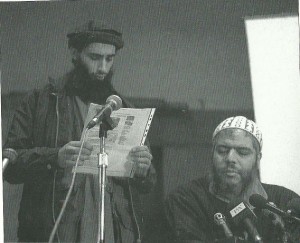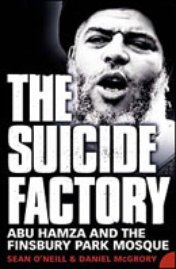2006 by Sean O’Neill and Daniel McGregory
Two journalists of The Times tell the story of ‘hate-monger’ Abu Hamza who preached at the Finsbury Park Mosque. What concerns us, is his allegation that three of the four alleged London-bombers frequented this mosque to hear him. Khan, Shehzad Tanweer and Germaine Lindsay were regularly photographed there by the security services, the authors tell us (p269): if this is so, why have we never been shown any of these photographs? This would have been excellent proof of the Government’s case – indeed, it would have clinched it.
This has been claimed earlier, eg The Times reported on the 2006 Abu Hamza trial:
Khan and Tanweer heard the cleric’s sermons inside the North London mosque. They and Lindsay were also among crowds that heard Abu Hamza preach on the street after the building was closed in a police raid in 2003.
MI6 Agent
All the evidence O’Neill and McGregory can show, is a photo (p.73) of Haroon Rashid Aswat, from Dewsbury, Yorkshire, clearly functioning as a ‘loyal aide’ for Abu Hamza. Readers may dimly recall that Haroon was fingered as the ‘mastermind’ of the 7/7 London bombings for a while, until it surfaced that he was an MI6 agent. That rather spoilt the story. The authors omit to inform us of this small detail. 
The authors claim that Abu Hamza had earlier preached in the Beeston area of Leeds and Tanweer and Khan were ‘so impressed’ – at this point I believe the authors are just making their story up.
Nafeez Ahmed came out with the same claim, also not giving any reference, and here was my ToT comment (Appendix 10):
‘Is Nafeez sure that Khan would really have had the time or inclination to drive all the way down to Finsbury Park to listen to some ranting mullah? Can he reconcile that with one of the most marked characteristics of Khan as recalled by the many who knew him, namely his lack of interest in religion? The Radio 4 program ‘Biography of a Bomber’ was the most detailed investigation of Khan’s life we are likely to hear about, and none of the persons there interviewed gave any hint that Khan had commuted down to Finsbury Park.’
As these journalists had earlier reported in The Times, they have Khan encouraging ‘his recruits to go to their mosques’ and he tells them about ‘his visits to hear radical figures like Abu Hamza explain their way.’ After each trip to a mosque Khan was always ‘eager to share what he had learned with his younger ‘brothers.’’ I spent quite few days at the ‘July 7th’ trial at Kingston in 2008 listening to young men who had known him quite closely, but there was never any hint of his visiting mosques. Had there been any story of his visiting Finsbury Park mosque or his being eager to tell others of that message, it would have been prime evidence which that court would have used.
‘One Finsbury Park veteran who played football with him (Khan) remembers him as ‘naturally aggressive’ He wanted to win at all costs, but you could tell he wanted to hurt people. When he tackled, he went for the man. You could see it in his eyes. He was up against bigger men, but he would never flinch. It was an honour thing for him.’ (p271) Sorry, I don’t believe a word of it! For the real Khan, see my chapter in ToT.
And why are these pipedreams so easy to make up? Its important that we answer this somewhat delicate question. One might suppose that there would be some group of British Muslims – after all there are three million in this country – who would be concerned with the historical truth of these matters, and maybe review or critique a book such as this. But, there isn’t. (1) British Muslims are quiet. There is no British Muslim journal. There are Muslim magazines and a Daily Jang newspaper, and lots of radio stations, mainly musical – but none will offer a political critique in a way that might doubt the government’s story (2). My book ToT has had reviews and I’ve been on radio and TV stations promoting it – but, never in any British-Islamic context: they would appear not to be interested, in a book that advocates Islamic innocence. So, this gives a degree of liberty to anyone who wishes to weave stories about Islamic terror in the UK. It’s a sad situation, but if British Muslims want it that way there in not much one can do about it. I’m not criticising them: if they want to take the blame, no-one can stop them. This may be to do with their religious belief, of submitting to the will of Allah. Enough said.
A student of Abu Hamza, Mr Al-Faisal, visited Beeston three times, conducting ‘religious study circles’ and ‘witnesses remember Khan peppering him with questions.’ ‘Khan became an avid collector’ of these taped sermons, we told. Jermaine Lindsay from Aylesbury also drove over to hear the message of hate and martyrdom of Abu Hamza: ‘He revelled in being part of the defiant Friday crowd gathered in protest outside Finsbury Park mosque to listen to Abu Hama.’ Half a dozen times he came ‘to kneel on a tarpaulin laid on St Thomas’s Road, and join in Friday prayers after the mosque had been closed and barricaded by police. He had listened intently to Abu Hamza al-Masri’s message of hatred, bigotry and intolerance.’
Or, maybe not.
Come on Sean O’Neill, I challenge you to provide us with just one speck of primary-source evidence in support of these claims? I suggest, you have none. You have just blended in the four young alleged bombers into your tale to buttress your Muslim terror-threat story.
The Crown vs Abu Hamza
On the morning of July 7th, Abu Hamza was on trial at the Old Bailey, for inciting his followers to perform ‘martyrdom operations.’ Suddenly all legal business was abandoned – lawyers walked out, the trial was abandoned. Not until January 2006 could he be tried. Now that is an impressive coincidence, and seems to have given the authors the argument of this book …. But it may not be quite enough to establish their case.
the Ricin Plot
For comparison, the authors do have a 15-page chapter entitled ‘the Ricin plot.’ What ricin plot? In the depths of Norfolk, police arrested an Algerian, in September 2002, who had in his possession some scribbled-out recipies, one for making the poison ‘ricin.’ ‘The discovery sent shock waves through the senior ranks of Britain’s security and intelligence community,’ we are informed (p.239). Gosh! The recipe was sent to Porton Down, Britain’s chemical weapons centre! (It was basically a recipe for extracting the stuff from fruit kernels). After this, ‘A range of terrifying scenarios began to course through the minds of senior officers’ – had they maybe been watching too many horror-movies? (NB, ricin is not a weapon of mass destruction – you may be able to kill one person with it)
Finally, on 5 January 2003 brave police ‘wearing protective clothing and masks’ burst in at dawn to 352b High Road, Wood Green, above a pharmacy. They found packets of rubber gloves, digital scales, some castor beans, plus a nivea jar containing nicotine! They did not actually find any ricin. The authors do manage to tell us this rudimentary fact. After that, the search for the ‘master-poisoner’ was on! But, hang on Mr O’Neill – no-one has been poisoned nor has anyone made any ricin.
In the old days crime was something you had actually done, not something an anti-terror chief reckoned you might be intending to do.
There was a ricin plot, but these two deeply clueless authors didn’t notice it. The US Secretary of State Colin Powell brandished a phial of what was allegedly ricin before the United Nations on 6th February, alleging that the London ‘terror cell’ was part of a global network originating in Iraq. The authors need to read ‘Flat Earth News, An Award-winning Reporter Exposes Falsehood, Distortion and Propaganda in the Global Media by Nick Davies. This describes how ricin-poison stories surfaced in the UK, France and Spain just prior to Colin Powell’s propaganda initiative for the Iraq war, alleging they had all derived from an Iraqi terror-cell. Donald Rumsfeld’s ‘Proactive, Preemptive Operations Group’ (P2OG) within the Pentagon was authorized to stimulate terror events pre-emptively and the Ricin plot smells like some such brewed-up plot. And by the way that Ricin recipe was from California not Pakistan.
brandished a phial of what was allegedly ricin before the United Nations on 6th February, alleging that the London ‘terror cell’ was part of a global network originating in Iraq. The authors need to read ‘Flat Earth News, An Award-winning Reporter Exposes Falsehood, Distortion and Propaganda in the Global Media by Nick Davies. This describes how ricin-poison stories surfaced in the UK, France and Spain just prior to Colin Powell’s propaganda initiative for the Iraq war, alleging they had all derived from an Iraqi terror-cell. Donald Rumsfeld’s ‘Proactive, Preemptive Operations Group’ (P2OG) within the Pentagon was authorized to stimulate terror events pre-emptively and the Ricin plot smells like some such brewed-up plot. And by the way that Ricin recipe was from California not Pakistan.
This book panders to the worst side of the British people, their need to believe in a collectively-experienced, demonised enemy image.
‘The London bombings’ by Nafeez Ahmed gives a more sensible view of Abu Hamza, showing how he worked as an MI5 asset at the Finsbury Park mosque for years (pp.158-167):
‘The evidence used to successfully prosecute Hamza in February 2006 had almost all been found by the police seven years previously… In his court testimony in early 2006 when on trial for terrorism, and race hate charges, Hamza confirmed that the British security services had sought to recruit him to monitor radical groups and individuals and to deter terrorist atacks before his 2004 arrest.’
We get no hint of this in this book by Times-journalists. And yet, this central. To quote from Ahmed again, ‘Every leading member of al-Qaeda’s Finsbury division – Omar Bakri, Abu Hamza, Abu Qatada – has according to credible reports, a close relationship to Britain’s security services.’ (p175).
1. OK, there is one: that of the Birmingham mosque ‘Dawn’ by Dr Naseem.
2. For comparison, the Global Peace and Unity yearly Islamic conference at Excel in East London did invite William Rodriguez to speak about 9/11 two years ago in 2008 – and found itself being warned by a Conservative MP not to do anything like that again! (I’ll try and get some more info on this matter)

